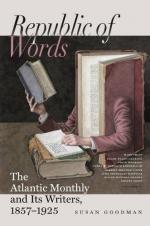His “Beatrice Cenci” was written during his imprisonment; and there is something fitting in the circumstance, that the work of an exile should be translated by a countryman also driven from his native land in consequence of his devotion to the idea of liberal and constitutional government, and, like the author, sustaining himself unrepiningly by a dignified and useful industry. It was also peculiarly fitting that the translation should have appeared just at the moment when the genius of Miss Hosmer had renewed the interest of her countrymen in the story of Beatrice, and deepened their compassion for her undeserved misfortunes by a statue so full of pathos and power.
Guerrazzi belongs to the extreme left of the school of historical novelists. He is almost always at high pressure, and, in spite of a certain force of thought and expression, is tinged decidedly and sometimes unpleasantly with sentimentalism. He is so little of an artist, that the story-teller is subordinated in him to the propagandist, and his work is not so near his heart as the desire to make a strong argument against the temporal power of the Papacy. He interrupts his narrative too often with reflection and disquisition, shows too much that fondness for the striking which is fatal to the classic in expression, and rushes out of his way at a highly-colored simile as certainly as a bull at scarlet. His characters talk much, and yet develope themselves rather circumstantially than psychologically.
Yet, in spite of these defects, Guerrazzi has succeeded in so intensifying the high lights and deep shadows of passion, pathos, and horror in the story, as to make a very effective picture, of the Caravaggio school. There is a curious parallel between the chapter where Count Cenci is imprisoned in the cavern, and those scenes in Webster’s “Duchess of Malfy” where the Duchess is tortured by her brothers. The resemblance is interesting on many accounts, and serves to confirm us in a belief we have long entertained that Webster’s peculiar power has been overrated, and that the tendency to heap one nightmare horror on another is something characteristic rather of the childhood than the maturity of genius. There is no modern story which renews for us the woes of the house of Tantalus so awfully as this of the Cenci, and it cannot fail to be of absorbing interest, especially to those unfamiliar with its ghastly details. Whether the theory which Guerrazzi assumes in order to render probable the innocence of the Cenci be tenable or not we shall not stop to discuss; it is enough that it serves to heighten the romance and complicate the plot in a very effective manner.
We cannot leave the book without saying how much we were charmed with the little episode of the old curate and his maid, and his ass Marco. It seems to us that Guerrazzi in this chapter has come nearer to the simplicity of nature than in any other part of the book, and we augur favorably from it for his future escape from the perils of a too ambitious style to the serenity of truer artistic development.




